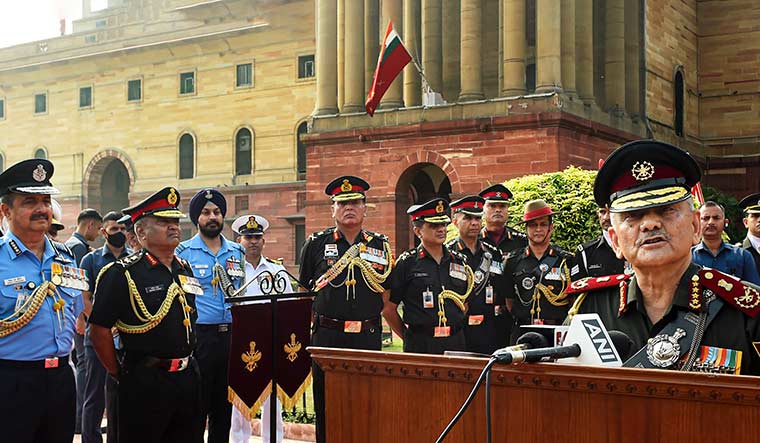THE CRISP MOUNTAIN morning of September 10 saw a blazer-clad gentleman alighting from an Army chopper at a hilltop helipad at Kibithu, Arunachal Pradesh. He was of medium height, with trimmed hair, military manners and a firm handshake. His name: Anil Chauhan, military adviser to the National Security Council Secretariat in Delhi and a retired lieutenant general.
Chauhan was in Kibithu for naming the military garrison there after Gen Bipin Rawat, who was chief of defence staff when he died in a chopper crash in the Nilgiri last December. For Chauhan, it might have been a personal pilgrimage—both he and Rawat hailed from Uttarakhand’s Pauri Garwal district and had their military moorings in the Lucknow-headquartered 11, Gorkha Regiment. Chauhan is also a connoisseur of Tibetan arts. Incidentally, some distance away from Kibithu, on the Tibetan side, lay the Chinese military post at Sapchu—those with perfect eyesight can see the village clearly; others would need binoculars.
Few could foresee that Chauhan would be called back from retirement 18 days after his Kibithu visit. On September 28, he was named as the new chief of defence staff (CDS), ending nearly 10 months of speculation regarding who would succeed Rawat. As the first-ever Army officer to come back from retirement to don a four-star general’s uniform and regalia, Chauhan will be the “first among equals” in the apex military quartet comprising the three service chiefs and the CDS.
“Gen Chauhan is highly focused, sober and deeply intelligent,” said security analyst Lt Gen (retd) Rakesh Sharma. “I have known Gen Chauhan throughout our service careers, as we are from the same regiment. We had served together in Army headquarters in the adjutant general’s branch in 2016. I have closely seen him working on the global competition on the design of the National War Memorial. He did superlative work in the finalisation of the design for the memorial.”
Chauhan was reportedly chosen after considering around 20 candidates. Apparently, his stint as Director General Military Operations (January 2018 to September 2019) and as adviser at the National Security Council Secretariat (NSCS), headed by National Security Adviser and fellow Garhwali Ajit Doval, gave him an edge.
It was during Chauhan’s tenure as DGMO that the Balakot air strike (February 26, 2019) in Pakistan and ‘Operation Sunrise’ (2019) against insurgents on the Indo-Myanmar border took place. He took over as the general officer commanding-in-chief of the Eastern Command in September 2019, overseeing the massive deployment and consolidation of Indian forces along the Line of Actual Control in Arunachal Pradesh.
In October 2019, Chauhan oversaw HimVijay, a novel military exercise to improve the Army’s offensive capabilities against China. At the centre of the exercise were integrated battle groups (IBGs)—self-contained fighting units that are slightly larger than brigade formations, and comprise a mix of infantry, artillery, tank, air defence and logistics units. IBGs have the potential to change the way wars are fought, and they have huge implications for India’s efforts to establish integrated theatre commands comprising the three services.
The game-changing airlift of US-made M-777 howitzers—they were slung underneath the newly-acquired Chinook helicopters—also happened around the same time as HimVijay. It caught the Indian military’s imagination, as the airlift promised to overcome the logistical challenges posed by geography and topography at one stroke.
After his retirement on May 31, 2021, Chauhan was intimately involved in the setting up of the National War Memorial, even as he was inducted into the NSCS as military adviser, affording him a closer look at the internal security situation in the country.
He has become CDS at a time when the Indian military is coming to prominence on the global stage, in keeping with the country’s growing economic and strategic heft. Unlike in the case of Rawat, who was named CDS before his retirement, Chauhan’s appointment came after several roadblocks were cleared and appointment rules tweaked.
In some circles, former Army chief Gen Manoj Mukund Naravane was seen as the next CDS, as a natural progression to having led the 13-lakh-strong Indian Army. But the fact that China’s incursions in eastern Ladakh and the violent skirmish between Indian and Chinese soldiers in Galwan Valley took place under his watch stacked up against him.
Without doubt, Chauhan’s appointment as CDS is a China-centric move, marking India’s changing military focus from Pakistan to China. It is now clear that policymakers consider China as India’s prime adversary, militarily and economically.
As CDS, Chauhan would have a lot on his plate. Prime among them would be the mega project that had stalled after Rawat’s sudden demise—setting up integrated theatre commands and ensuring jointness of services in military operations. There are also ruffled feathers that will have to be smoothened. The Air Force, for instance, has reservations against dividing its already scarce platforms and assets to set up theatre commands.
“We are not opposing any process of integration or any process of theatre commands,” said Air Force chief V.R. Chaudhari recently. “We have certain reservations with respect to the structures…. Each service has a doctrine. The doctrinal aspects of the IAF should not be compromised in any way by the new structures.”
Chauhan knows that theatre commands come with huge challenges. Setting up such commands involves not just the amalgamation and integration of personnel, but also of weapons systems and platforms. It calls for the infusion of artificial intelligence-centric technology, which in turn would require the deployment of massive resources and funds in an unprecedented scale.
The prevailing conditions, however, are unlikely to help Chauhan in his mission. There are economic challenges (the rupee’s slide, depleting forex reserves), geopolitical uncertainties (Russia-Ukraine war) and political priorities (the next round of assembly polls in several states) that could draw out resources and funds that could otherwise have been used for military modernisation—an imperative for setting up theatre commands.
In a nutshell, Chauhan faces unprecedented challenges in his new assignment. But, as a hardy Garhwali, he could well prove equal to the task.


